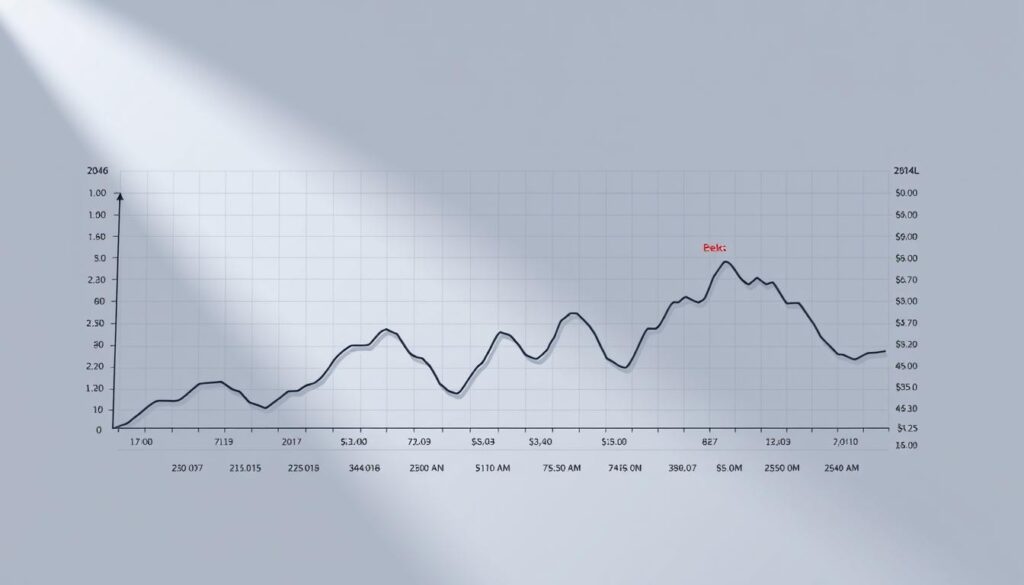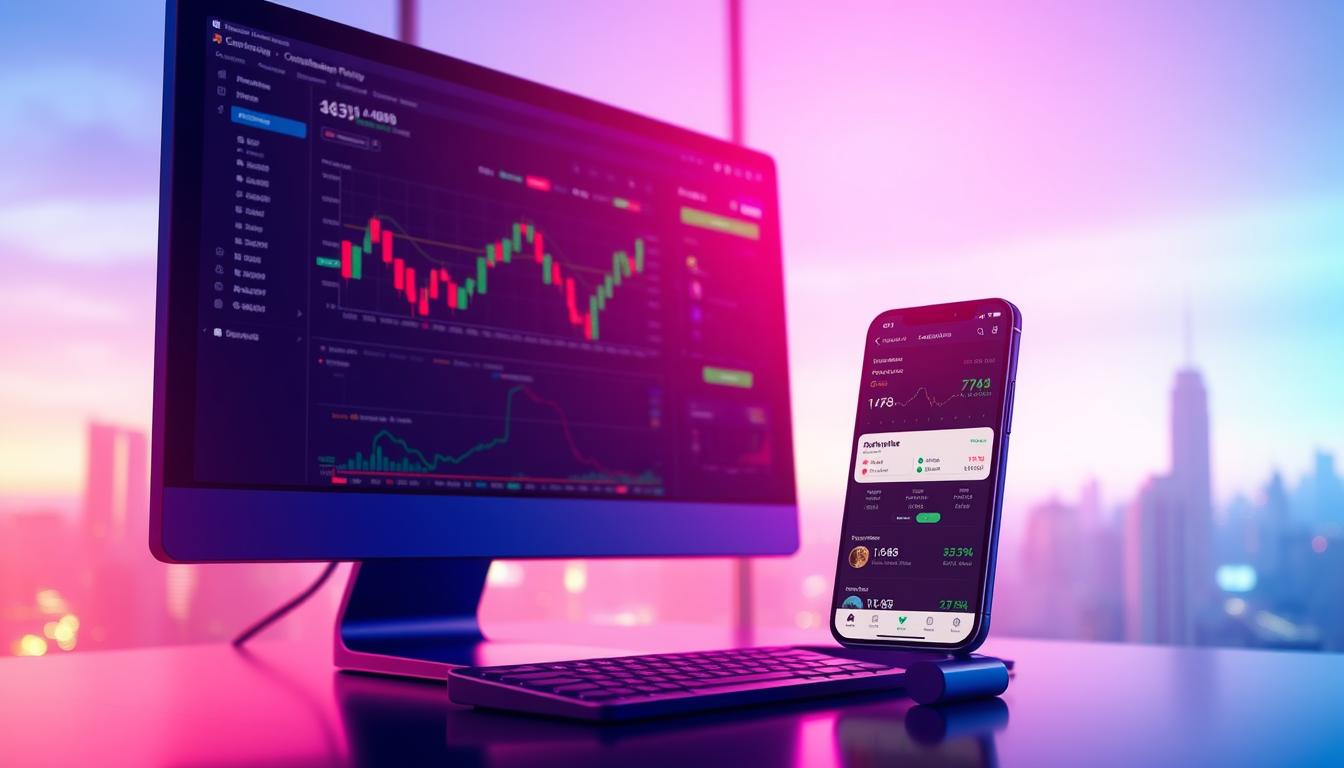Now Reading: Cryptocurrency Market Cycles History Patterns Explained
- 01
Cryptocurrency Market Cycles History Patterns Explained
Cryptocurrency Market Cycles History Patterns Explained

Since Bitcoin’s launch in 2009, the world of digital assets has been defined by powerful waves of growth and decline. These recurring phases are not random. They follow a recognizable sequence that many investors watch closely.
Knowing how these patterns work offers a major advantage. It helps traders and enthusiasts make smarter choices in a fast-moving landscape. This article will break down the major bull runs from the past decade.
We will look at what caused each surge and what we can learn from them. Digital asset movements are often more intense than traditional finance. Big gains can happen quickly, but so can corrections.
By studying past events, you can spot opportunities during quiet times. You can also recognize signs of too much excitement. Our goal is to give you a clear framework for understanding these powerful financial tides.
Key Takeaways
- Digital assets move through predictable phases of growth and decline.
- Studying past events provides valuable insights for future decisions.
- Major price surges are often driven by specific catalysts.
- These movements are typically more volatile than traditional markets.
- Recognizing different stages can help identify strategic entry and exit points.
- External factors like technology and regulation play a significant role.
- A historical perspective helps manage expectations and risk.
Understanding cryptocurrency market cycles history patterns
A crypto asset cycle represents the recurring journey from a market bottom to a peak and back again. These phases are driven by collective investor psychology and fundamental events. Recognizing each stage is crucial for strategic decision-making.
Each full sequence contains four distinct stages. They are accumulation, markup, distribution, and markdown. The table below outlines the key characteristics of each phase.
| Phase | Investor Sentiment | Price Action | Typical Activity |
|---|---|---|---|
| Accumulation | Pessimism, Fear | Low Volatility, Sideways | Smart money accumulates assets quietly. |
| Markup | Optimism, Greed | Strong Uptrend | New investors enter; media attention grows. |
| Distribution | Euphoria, Denial | High Volatility, Topping | Early investors take profits. |
| Markdown | Panic, Capitulation | Sharp Downtrend | Weak hands sell; prices decline significantly. |
Defining Market Cycles in the Crypto Space
The accumulation phase occurs after a severe bear period. Prices stabilize near long-term lows with little public interest. This is when informed participants build positions.
Next, the bull cycle begins with the markup phase. Confidence returns, leading to sustained price appreciation. Excitement builds as the trend strengthens.
Significance of Historical Patterns for Future Trends
Studying past sequences provides a valuable framework. While each event has unique drivers, psychological patterns often repeat. This history helps identify potential opportunities and risks.
Digital asset movements are notably faster and more intense than traditional finance. This volatility creates unique challenges and rewards for those who understand the rhythm.
Historical Bull and Bear Cycles: Lessons from Bitcoin
2013 represented a turning point for Bitcoin as it experienced its first substantial price appreciation that captured global attention. This period established foundational patterns that would characterize future digital asset movements.
2013: The Inception of Bull Runs
Bitcoin’s value surged from approximately $145 in May to over $1,200 by December 2013. This 730% increase demonstrated the asset’s potential during the Cyprus banking crisis.
Media coverage expanded awareness beyond technical enthusiasts. Early exchange infrastructure improved accessibility, fueling the bull momentum.
Impact of Early Setbacks and Recovery
The Mt. Gox collapse in early 2014 triggered a severe bear period. BTC fell 75% from its peak, shaking investor confidence.
Yet the 2017 bull run proved remarkably resilient. Bitcoin surged from $1,000 to nearly $20,000, a 1,900% gain. The ICO boom drove massive retail participation.
This history of Bitcoin’s major movements shows that dramatic gains often precede corrections. Each cycle leaves improved infrastructure.
| Event | Price Movement | Key Catalyst |
|---|---|---|
| 2013 Bull Run | $145 to $1,200 (+730%) | Cyprus banking crisis, media attention |
| 2014 Bear Market | 75% decline from peak | Mt. Gox exchange collapse |
| 2017 Bull Run | $1,000 to $20,000 (+1,900%) | ICO boom, retail investor surge |
These events teach valuable lessons about volatility and recovery. Long-term holders who maintained conviction through difficult periods were ultimately rewarded.
Drivers Behind Bitcoin’s Bull Runs and Halving Events
A predetermined event coded into Bitcoin’s DNA creates predictable supply shocks that have historically fueled major price surges. These bitcoin halving events occur approximately every four years, cutting mining rewards in half.

The Role of Halving Events in Price Appreciation
Each halving reduces the daily issuance of new coins. This creates scarcity when demand remains steady or increases. Historical data shows impressive gains following these events.
The table below demonstrates the impact of past halving cycles:
| Halving Year | Reward Reduction | Subsequent Price Increase | Time to Peak |
|---|---|---|---|
| 2012 | 50 to 25 BTC | 5,200% | ~12 months |
| 2016 | 25 to 12.5 BTC | 315% | ~18 months |
| 2020 | 12.5 to 6.25 BTC | 230% | ~17 months |
| 2024 | 6.25 to 3.125 BTC | New ATH achieved | Immediate impact |
Institutional Investment and Increased Adoption
Recent halving events have coincided with growing institutional participation. Companies like MicroStrategy and Tesla added Bitcoin to their balance sheets.
The 2024 bitcoin halving saw unprecedented institutional involvement through spot ETF approvals. This combination of supply reduction and increased demand creates powerful upward price pressure.
Market Sentiment and Investor Behavior in Crypto Cycles
Investor psychology plays a crucial role in shaping the dramatic price swings seen in digital assets. These emotional patterns create predictable phases that repeat across different time periods.

The collective mindset of participants drives momentum in both directions. Understanding these psychological shifts can provide valuable insights for strategic decisions.
Understanding Bull Market Psychology
During upward trends, investor sentiment evolves through distinct stages. It begins with cautious optimism as prices start recovering from lows.
Confidence grows as gains accumulate, leading to increased participation. This bull market psychology eventually reaches extreme greed and FOMO.
Social media amplifies these emotions through powerful feedback loops. Positive coverage attracts new participants, driving prices higher.
| Psychological Phase | Investor Behavior | Market Characteristics |
|---|---|---|
| Disbelief & Hope | Cautious accumulation | Low volatility, sideways movement |
| Optimism & Confidence | Increased buying activity | Sustained upward trend |
| Euphoria & Greed | FOMO-driven participation | High volatility, peak prices |
Analyzing Bear Market Corrections
Downward movements follow a different emotional sequence. The shift begins with denial as participants dismiss early warning signs.
Anxiety increases as losses mount, eventually turning into panic. Weak hands sell during capitulation phases, creating significant price declines.
Recognizing these bear market patterns helps avoid emotional decision-making. Contrarian thinking during extreme pessimism often presents opportunities.
Fundamental Tech and Regulatory Influences on Crypto Markets
Beyond price charts, fundamental tech breakthroughs and regulatory decisions are the true engines of crypto market movements. These powerful factors create the conditions for major price events and long-term trends.
Understanding their impact is crucial for navigating the digital asset landscape.

Technological Innovations Driving Crypto Adoption
Each significant uptrend in the crypto market has been fueled by a key innovation. The 2017 surge was powered by the ICO boom and smart contracts on Ethereum.
This technology allowed new projects to raise funds and build applications.
The 2020-2021 period saw the rise of DeFi and NFTs. Protocols like Uniswap offered new financial services.
NFTs brought blockchain tech to art and collectibles, expanding its use.
Regulatory Shifts and their Market Impact
Government actions are another critical force. Restrictive measures can quickly cool a hot market.
China’s 2017 ban on ICOs is a prime example of negative impact.
Conversely, supportive rules can unlock massive growth. The 2024 U.S. approval of Bitcoin ETFs was a landmark event.
It provided a safe, familiar way for big investors to enter the crypto space.
| Catalyst | Type | Market Impact |
|---|---|---|
| Ethereum & ICOs (2017) | Technology | Democratized fundraising, sparked a retail boom. |
| DeFi & NFTs (2020-21) | Technology | Expanded utility beyond payments, attracted new users. |
| China ICO Ban (2017) | Regulation | Triggered a significant correction and sell-off. |
| U.S. Bitcoin ETF (2024) | Regulation | Opened doors for institutional capital inflows. |
The interplay between tech advancement and regulatory clarity remains a defining feature of the crypto world. These factors will continue to shape future cycles.
Impact of Global Macroeconomic Factors on Crypto Cycles
The global economy now plays a pivotal role in shaping the trajectory of digital asset valuations. As the space matures, traditional financial factors exert a stronger impact.
Institutional participation has linked digital assets to broader economic trends. This connection makes understanding the macro environment essential.

Interest Rates, Economic Uncertainty, and Market Shifts
The relationship between interest rates and asset performance is critical. Low rates make riskier investments more attractive.
This was evident during the 2020-2021 surge. Massive monetary stimulus flooded the system with capital.
Investors sought assets like Bitcoin to hedge against inflation. This behavior highlights a key shift in perception.
Central bank policies directly influence liquidity. Expansionary measures typically support upward trends.
Conversely, tightening policies can create significant headwinds. Navigating these changes is a modern challenge for traders.
| Monetary Policy | Liquidity Condition | Typical Market Impact |
|---|---|---|
| Expansionary (QE, Low Rates) | High Liquidity | Supports risk asset appreciation |
| Contractionary (Rate Hikes, QT) | Reduced Liquidity | Creates selling pressure and consolidation |
Economic instability often accelerates adoption. Events like banking crises demonstrate the appeal of decentralized alternatives.
The overlap between global economic cycles and digital asset cycles is now significant. Future movements may depend heavily on these macro factors.
Analyzing Technical Indicators During Bitcoin Bull Runs
Traders use specific tools to gauge momentum and identify potential turning points in price action. These technical signals provide quantifiable data to support decision-making.
Key metrics help navigate the inherent volatility of digital assets. They offer clues about trend strength and possible corrections.
Moving Averages and Relative Strength Indicators (RSI)
The relationship between the 50-day and 200-day moving averages is a classic signal. A “golden cross,” where the 50-day crosses above the 200-day, often marks the start of a strong bull phase.
This cycle saw this event occur for a second time, a rare occurrence. Historically, this has led to significant price appreciation over the following year.
The RSI measures the speed of price changes. Readings above 70 suggest strong buying momentum, as seen recently.
On-Chain Data and Wallet Activity Insights
On-chain metrics offer a real-time view of investor behavior. They show what is happening beneath the surface price action.
Rising wallet activity and stablecoin inflows signal growing participation. A decline in BTC reserves on exchanges often indicates long-term accumulation.
The current bull run has shown remarkably low volatility. It has experienced far fewer sharp corrections compared to past market phases.
| On-Chain Metric | Bullish Signal | Bearish Signal |
|---|---|---|
| Exchange Reserves | Declining BTC balance | Increasing BTC balance |
| Stablecoin Supply | Inflow to exchanges | Outflow from exchanges |
| Wallet Activity | Rising new addresses | Stagnant or falling activity |
Combining these tools with fundamental analysis creates a powerful trading framework. No single indicator is perfect, but together they paint a clearer picture for trading decisions.
Crypto Market Trends: From Past Cycles to Future Outlook
Strategic positioning in the digital asset space depends heavily on recognizing recurring temporal and psychological sequences. Previous upward movements reveal that explosive gains often concentrate in the final 3-4 months before peaks.
This period carries both tremendous opportunity and significant risk as euphoria reaches maximum intensity. The 2013, 2017, and 2021 surges all peaked between November and December.
Learning from Previous Cycle Patterns
Each crypto bull phase has unique drivers but shares common behavioral characteristics. The diminishing returns pattern shows percentage gains decreasing as capitalization grows.
After the 2012 event, Bitcoin surged 5,200%. The 2016 period brought 315% gains, while 2020 saw 230% appreciation. This trend suggests investors should adjust return expectations while recognizing substantial absolute gains remain possible.
Predicting Future Trends in a Maturing Market
The current bull phase following April 2024’s supply reduction shows unprecedented characteristics. Bitcoin reached new highs before the event—something never seen before.
Based on median duration patterns, this cycle could peak between October 2025 and early 2026. However, institutional participation through ETFs may alter traditional timing.
The maturing landscape requires adaptable analysis. While past patterns provide frameworks, each cycle brings distinctive developments in technology and regulation.
Preparing for the Next Bitcoin Bull Run
Smart preparation for future price appreciation starts long before the upward trend becomes obvious. The best opportunities often appear when sentiment is low and assets trade at discounts. Building positions during these quiet periods sets the stage for success.
Smart Investment Strategies and Risk Management
Dollar-cost averaging (DCA) provides a disciplined approach to building exposure. This strategy involves regular purchases regardless of short-term price movements. It helps avoid emotional decisions during volatile periods.
Setting clear profit-taking targets is equally important. Decide in advance what percentages to sell at specific price levels. This removes guesswork when emotions run high during rapid appreciation.
Diversification remains crucial for managing risk. While BTC typically leads initial rallies, other digital assets often deliver stronger gains later. Focus on projects with real utility and active development teams.
| Strategy | Bear Market Application | Bull Market Application |
|---|---|---|
| Dollar-Cost Averaging | Accumulate positions systematically during price declines | Take profits gradually as prices reach predetermined targets |
| Portfolio Diversification | Build core positions in established assets like Bitcoin | Rotate profits into quality projects with strong fundamentals |
| Risk Management | Use position sizing to limit exposure to any single asset | Implement stop-loss orders to protect gains during corrections |
Timing Entry Points Based on Historical Signals
The April 2024 halving event created a new supply dynamic for Bitcoin. Combined with massive ETF inflows, this cycle shows unique institutional participation. These factors may alter traditional timing patterns.
Historical signals like the 200-week moving average provide useful accumulation zones. Technical indicators can identify oversold conditions ideal for building positions. The current bull phase presents both opportunity and need for caution.
Successful trading requires adapting to changing market conditions. While past patterns offer guidance, each cycle brings new developments. Stay informed and maintain disciplined risk management throughout the entire process.
Conclusion
The progression from early retail excitement to institutional acceptance marks Bitcoin’s maturation story. Each major upward trend has contributed to building a more robust financial ecosystem.
From the 2013 surge to the 2020-2021 institutional embrace, these events show clear evolutionary patterns. The recent ETF approval represents another milestone in this journey.
While percentage gains may decrease as the space matures, absolute opportunities remain substantial. Successful participation requires understanding both the psychological and fundamental factors driving each phase.
The long-term trajectory points toward greater integration with traditional finance. Each cycle leaves improved infrastructure and broader acceptance, strengthening the foundation for future growth.
FAQ
What are the main phases of a crypto bull and bear market?
A typical cycle has four main stages. The bear market is a period of declining prices and low investor sentiment. This is followed by an accumulation phase where prices stabilize. The bull market then begins, characterized by rising prices and high optimism. Finally, a distribution phase occurs before a potential correction, completing the cycle.
How does the Bitcoin halving event influence the market?
The Bitcoin halving is a scheduled event that cuts the reward for mining new blocks in half. This reduces the rate of new BTC supply. Historically, these events have preceded significant price increases. The reduced supply, coupled with steady or growing demand, often creates upward pressure on the asset’s value.
What role does market sentiment play in these cycles?
Investor sentiment is a powerful driver. During a bull run, excitement and fear of missing out (FOMO) can drive prices to a peak. In a bear market, fear and pessimism can lead to sharp corrections. Understanding this psychology is key for trading and managing risk.
Besides the halving, what other factors drive bull runs?
Several factors contribute. Institutional investment from major companies brings credibility and capital. Increased adoption by the public expands the user base. Technological innovations and shifts in the global macroeconomic landscape, like changes in interest rates, also have a major impact.
How can historical patterns help predict future trends?
While history doesn’t repeat exactly, it often rhymes. Analyzing past halving cycles, price action, and volatility can reveal common patterns. These insights help investors identify potential entry points and manage expectations, though future markets will always be influenced by new, unpredictable factors.















